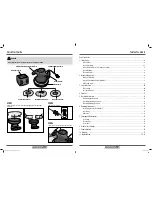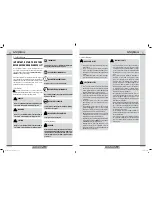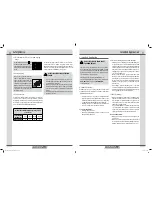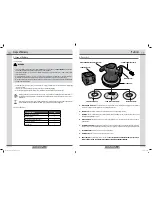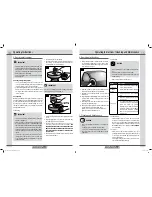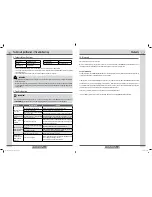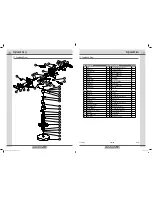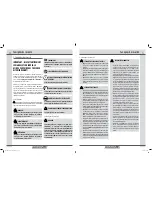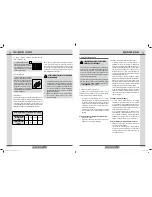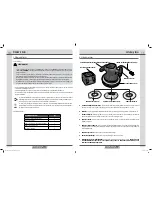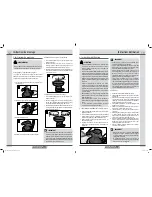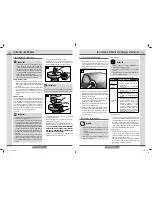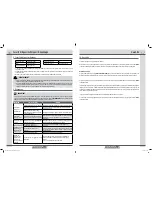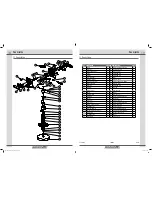
15
14
Operating Instructions / Cleaning and Maintenance
Operating Instructions
6. Operating Instructions
ImPORTanT
•
All polishes will go through stages as they breakdown. Each
product is different, but basically their look goes from wet,
hazing, translucent, to dry or oily. Without going through
these stages you will not get the full effect of the polish and
will most likely leave a hazed finish.
•
For more polishing details, see the instructions provided
with your polish.
Preventing burning through paint
•
It is easy to burn through the paint on a surface. This can
occur if you polish at too high a speed or if you let the bonnet
(F) stay at one spot even for a short period of time.
•
To prevent burning through paint, choose a lower speed and
keep the tool moving constantly, especially when working
near edges or where there are abrupt changes in the contour
of the work surface.
Proper lighting
Without proper lighting, the majority of swirls and scratches are
not visible. In addition, a lack of good lighting makes it very hard
to see the polish breaking down, especially on light coloured cars.
If possible, try to polish under controlled lighting. The sun can
sometimes be masked by clouds, haze, or fog and can hide swirls,
hazing and imperfections.
6.3 Waxing
ImPORTanT
•
It is very important that your working surface is clean and
dry before applying wax.
•
The most common error when waxing is applying too much
wax. If the foam pad (C) becomes saturated with wax, wax
removal will be more difficult and will take longer. Applying
too much wax may also reduce the life of the foam pad (C).
If the waxing applicator (D or E) continually comes off the
foam pad (C) during use, too much wax may have been
applied.
•
It is easiest to apply wax to the entire surface before
starting the wax removal process. For best results, refer
to the specific application recommendations of the wax
product being used.
1. Assemble the power tool for waxing.
2. Apply wax (not included) evenly on the waxing applicator
(D or E) (Fig. 7). The amount of wax needed will vary
according to the size of the work surface.
7
Wax
ImPORTanT
You can also substitute a good grade cleaning compound at
this step if the surface is oxidized (Fig. 8).
8
ClEanInG
COmPOUnD
3. Hold the tool firmly by its two handles (B, H) and switch the
tool on.
4. Begin applying the wax to the work surface with long
sweeping strokes in a criss-cross pattern.
5. Apply more wax to the applicator (D or E) as necessary
to maintain a thin, even coat on the work surface.
fOR
aDDITIOnal aPPlICaTIOnS Of ThE Wax, REDUCE ThE
amOUnT aPPlIED. ThE WaxInG aPPlICaTOR (D OR E)
WIll nOT aBSORB aS mUCh Wax In SUBSEQUEnT
aPPlICaTIOnS.
6. After the wax has been applied to the work surface, switch
the tool off and unplug it.
6. Operating Instructions
7. Remove the applicator (D or E) from the foam pad (C) and
use it manually to apply the wax to those hard-to-reach
areas, such as near and around mirrors, lights, door handles,
under bumpers, etc. (Fig. 9).
9
8. Allow sufficient time for the wax to dry on the work surface.
Afterwards, assemble the power tool for polishing.
9. Switch the tool on and allow the foam pad (C) to reach its
fullest speed.
10. Begin polishing by lightly buffing off the wax residue in a
circular pattern. Continue polishing until the entire wax
residue is removed.
11. After the wax has been removed from the work surface,
switch the tool off and unplug it.
12. Remove the polishing bonnet (F) from the foam pad (C) and
use it manually to remove the wax from those
hard-to-reach areas, such as near and around mirrors,
lights, door handles, under bumpers, etc.
7. Cleaning and maintenance
DanGER
•
Before any adjustment, maintenance or cleaning, make
sure to
- Unplug the power tool from the electrical outlet.
- Let it come to a full stop before placing it on the back.
•
Do not expose the power tool to humidity or extreme
temperatures.
7.1 Cleaning
CaUTIOn
•
Never use flammable or combustible solvents around the
tool.
•
Never immerse the tool in water or other liquids.
•
Never let water or other liquids reach the inside of the tool
during cleaning.
•
Remove all detachable parts from the tool.
PaRTS
hOW TO ClEan...
Wax
applicators
•
Soak in a warm solution of water and mild
soap for about 10 minutes.
•
Rinse with clean water and let it dry well.
Polishing
bonnet
Tool casing
•
Clear dust and debris off all ventilation
slots.
•
Keep the tool handles clean, dry and free
of oil or grease.
•
Use a damp cloth and mild soap only to
clean the tool casing, as certain cleaning
agents and solvents (e.g. gasoline,
turpentine, lacquer thinner, paint thinner,
chlorinated cleaning solvents, ammonia
and household detergents containing
ammonia, etc) are harmful to plastic and
insulated parts.
7.2 lubrication
•
Self-lubricating bearings are used in this tool so periodic
re-lubrication is not required. However, it is recommended
that once a year, you have this tool thoroughly cleaned and
inspected by an authorized technician. For details, please call
the SIMONIZ Toll-free service number at
1-866-4SImOnIz
(1-866-474-6664).
7.3 Storage
•
Always ensure to remove the wax applicator (D or E) or
polishing bonnet (F) from the foam pad (C) when the power
tool is not in use. This will allow the foam pad (C) to dry and
retain its original shape.
•
To prolong the foam pad's life and shape, ensure to store the
power tool with the pad (C) facing up.
039-9055-6-Polisher kit-EN-FR-02.indb 14-15
11/9/12 4:10 PM


